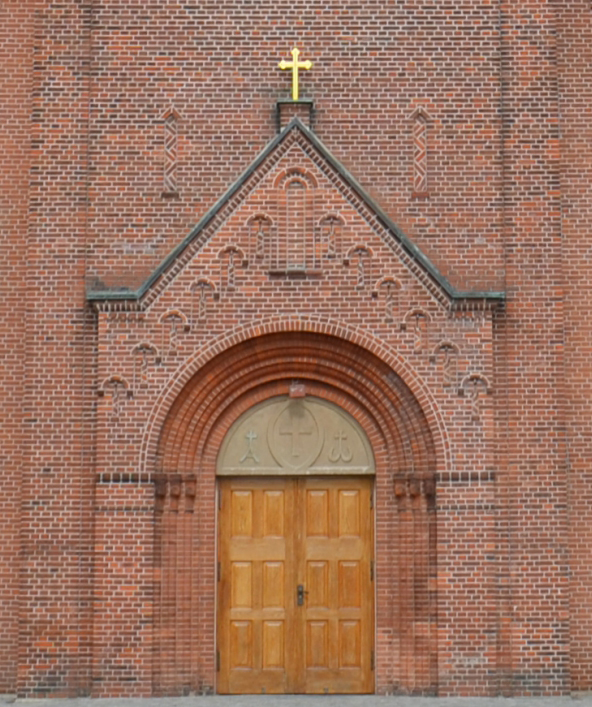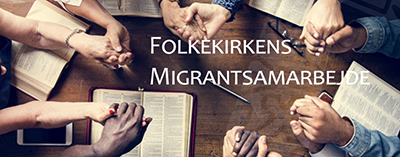Intercultural encounters in the Danish church in 2010s
The church as a social caretaker became less common throughout the 20th century as the Nordic welfare state increasingly took over this task. Churches which engage in social activities are arguably reclaiming this role, such as the increasing number of churches in the Danish People’s Church engaging in intercultural activities. These local activities often counter national political anti-immigration sentiment and the tendency to make the welfare state inaccessible to outsiders. They also exemplify the challenges facing the modern church: the need to reflect local conditions on the one hand and the state on the other.

Who are the ‘people’ in the People’s Church (folkekirke)?
Until the 20th century, folkekirker or people’s churches in the Nordic countries were considered charitable institutions providing different kinds of health and social care initiatives. With the development of the welfare state, these initiatives were increasingly taken over by the state. Some scholars consider the development of the Nordic welfare state’s egalitarianism and the citizen’s right to equal goods regardless of social status as based on inherently Lutheran values. Still, the development of the welfare state has historically caused the church’s realm to become less socially and societally directed and more reserved for explicitly religious purposes.
The Evangelical Lutheran Church in Denmark (ELCD) is a national religious organisation governed by the Danish state, yet individual churches also function as local organisations. While freedom of religion was enacted as statute in 1849 and the Evangelical Lutheran Church was no longer considered a state church, as a folkekirke (‘people’s church’), it still has a privileged position and remains tightly connected to the Danish state. This means that the ELCD is in between state and civil society; on the one hand, it is governed by the state, and on the other hand it incorporates self-determining local, semi-autonomous organisations. This double nature constitutes a double-bind for the ELCD encountering migration in local Danish contexts as it raises the question whether the church is obliged to follow the state, or whether it criticise or counteract Danish state regulations and attitudes towards migrants and refugees.
| The use of the very broad and heavily discussed term 'intercultural' in this article encompasses interreligious as well as inter-Christian relations and different groupings of immigrants in Denmark of different national origin and of different status of residence. |
| The term 'migrant' encompasses newcomers to Danish society regardless of whether they have been officially granted a residence permit or not. Motivations for migrants and refugees to attend churches varies. Some say it is to manage their new situation in Danish society including basic livelihood needs, but language development and having a place to meet new friends and build relations is also often cited. Some also attend for more specific religious reasons as they are Christian or with the purpose of conversion. |
The Danish political climate is becoming more hostile towards migrants, reflecting a growing political populist climate in Europe and globally, and this has led to debates regarding how far ‘welfare’ extends. It has been discussed whether it should only extend to national citizens, or to those who happen to be living within the borders of the state for shorter or longer periods, or to those with or without a resident permit. While it is complicated for the church to be critical of the state of which itself is a part, local churches may of course choose to counteract the increasingly hostile political attitude towards migrants through their work. Some claim that Christian hospitality as a virtue overrules the politics of respective states. On the other hand, other voices agitate for the preservation of Christian values as the national foundation towards outsiders’ influence, especially what they see as a threat from Islam.
Regardless of these debates, there currently seems to be an increase in churches in Denmark working alongside NGOs enacting what could be called a reclaiming of the charity and hospitality which was overtaken by the welfare state. Examples of such activities include engagement with neighbouring multicultural social housing through language cafés and meal fellowships. Of course, migration is not a new phenomenon or a new area of interest for churches. It is part of the Abrahamitic narratives from the Old Testament stories about the Israelites exiled in Egypt and onwards. People have always been on the move and churches as well as other societal organisations have reacted to these moves in various ways. But, in light of increased global migration – and not least increased focus on the migration - it appears that new initiatives have begun and there is increased awareness of migrants.

Of the eight key points on working together with migrants, number two is that "Both new and old members of the church must change in order to be open to building new relationships." (our translation) Photo: The Danish People's Church, working together with migrants website.
The landscape of intercultural encounters in the Danish church
The church has been accused of thwarting integration as only 2.9% of immigrants from non-western countries are members of the church compared to 85.9% of Danes. What the 'membership' designation covers is, however, only those who are baptised and official members of the Evangelical Lutheran Church in Denmark and not those who attend activities in church. Despite the low number of migrant members, there are an increasing number of Danish churches which actively engage in encounters targeted at Christian and non-Christian newcomers in Danish society.
A mapping based on website searches and snowballing interviews with pastors shows that more than 70 churches within the ELCD are currently involved in different designated intercultural activities. These activities encompass language cafés, meal fellowships, children’s’ clubs, Bible study groups etc. entitled "intercultural”, “international”, “cross-cultural” or the like. The number does not reflect those activities which are not specifically designated as intercultural, but of course migrants also attend other activities as well.
Engagement in interculturality is varied and often connected to geographical and demographical factors. City churches are more likely to be situated in areas where many migrants live, for instance social housing areas or where there are nearby asylum centres. Some churches have been engaged in the field of interculturality for decades, although others have just begun. Two practical theological, ethnographic field studies of such churches were undertaken in 2018. Practical theology is a field of research in how Christian religion is currently expressed in concrete practices in and outside religious spheres. Preliminary findings which can be extrapolated are as follows:
- Motivation of the existing congregation: The motivation for engaging in interculturality varies among and within churches. Some members of the church wish to enter into dialogue with those who think differently to ensure peaceful coexistence and interreligious understanding, while others are motivated by evangelism. Regardless of theological position, the ethical demand for Christian congregations to enact the love of God by following the ideal of Jesus and to help those in need is a major motivation to care for the marginalised. Pastors and congregation members describe how the presence of non-Danes in the church is a visible manifestation of the fellowship in the church as a place that is open for everyone regardless of social status, skin colour or other divides in society.
- Uncertainty for migrants encourage them to seek out church: Many migrants in Denmark who encounter churches live in uncertainty. Some are waiting for the outcome of their application of asylum, some have temporary residence permits, and many live under uncertain conditions regarding housing, work and income, education, and family relations etc. The changing situation of migrants is a result of, for example, asylum centres opening and closing, groups settling and moving. Added to this is the perception that society increasingly deems them as outsiders not only socially but also politically. Although this means that intercultural activities are often characterised by their temporary nature, this uncertainty is part of migrants’ motivation for coming to church in many incidences. A lot of migrants – Christian and non-Christian – express how they perceive a church as a place offering help or guaranteeing a hospitable environment to stay in. This perception appears to be as a result of church experiences in their home country or during their flight to Denmark.

Some Danes cite evangelism as one of the reasons for organising intercultural activities. Photo: Ben White, Unsplash.
- Social integration as an explicit aim of the church: Many intercultural activities in churches have social integration as enabling participation not only in the church fellowship but also in society as an explicit aim. This includes activities such as language cafés, meal fellowships, children's clubs and the involvement of migrants in different practical tasks in the church. Some churches also invite migrants to activities with the explicit purpose of intercultural exchange or interreligious dialogue.
- Explicit relation-building: Activities which focus on the relation-building between Danes and non-Danes often encounter challenges. On a pragmatic level, enabling non-Danes’ participation in church practices requires special attention. An obvious example is the need for translation and thoughtful communication to bridge language barriers. Another example is interpretation in a broader sense between norms and customs. This implies a double direction of explaining and introducing to Danish society, culture, food culture etc. on the one hand, and giving space for remembrance of norms and traditions from migrants on the other. Such cultural sensibilities requires patience and tolerance from both parts. In some cases, lack of these considerations seems to hinder relation-building. An example of this is how Danes can retreat from intercultural encounters if they are uncomfortable with how order and norms in the church are challenged, e.g. waiting in line, noisiness, children’s behaviour. Another example is how the Nordic mentality of being private and reserved in their attitude towards strangers – for instance not instantly inviting a newcomer to your home – makes non-Danes feel unwelcome.
In situations of encounters between Danes and migrants in Danish society, it is not surprising that roles of givers and receivers, hosts and guests, appear. Likewise, in a traditional national church, Danish members are naturally hosts and non-Danish non-members guests. Yet, fieldwork experience indicates how living up to the ideal about church as open fellowship requires more than inviting into practices which are already there. As such, roles of hosts and guests can be blurred. Building relations and social integration demands elasticity of status quo allowing the ‘other’ to become co-definers of church practices. These preliminary findings suggest that the Danish church is resisting change, but simultaneously showing an ability to change. It can be argued that balancing tradition with enabling newcomers to play a role is crucial for the church not only in relation to migrants in Denmark but more generally for the church to stay relevant in a society. Intercultural encounters also underline the need of many newcomers in Danish society to get help in managing how they become part of Danish society. Intercultural activities in churches might be reclaiming the church as a space for those on the edge of society and indirectly bring the selectivity of the welfare state model to the fore for public debate.
Further reading:
- Daisy Machado, Bryan Turner & Trygve Wyller, eds., Borderland Religion. Ambiguous practices of difference, hope and beyond (London: Routledge, 2018).
- Margit Feischmidt, Ludger Pries & Celine Cantat, ed., Refugee Protection and Civil Society in Europe (Palgrave Macmillan, 2019).